
It allows to keep PV going, with more focus towards AI, but keeping be one of the few truly independent places.
-
Didn't realize h265 is predicted to become available in 2013:
http://reviews.cnet.com/8301-13970_7-57387626-78/qualcomm-shows-horsepower-of-next-gen-h.265-video/
-
Parasites started to feel something
Building on the success of its HEVC/H.265 Patent Pool, Access Advance today announced its new HEVC Advance Platform Pool structure. The new and simplified structure will benefit both HEVC implementers (licensees) and HEVC standard essential patent owners (licensors).
Licensees will receive an expanded license which now includes all HEVC Profiles through Version 7 at the existing Main/Main 10 royalty rates, eliminating the separate additional royalties required under the current license for Version 2 HEVC Profiles and Optional Patents. New Licensees to the HEVC Advance pool will execute the new Platform License and immediately have the benefit of the new expanded license. Existing licensees may transition over to the new Platform License at any time, and are encouraged to do so promptly in order to avoid any future royalty obligations for Version 2 Profiles and Optional Patents under their existing licenses.
Current Licensors—and any other entities that believe they have essential patents—may now submit Version 3-7 Profile patents for evaluation and inclusion in the license, thus earning royalties for these more recent inventions. Additionally, under the new Platform License all licensors will now be eligible to receive a minimum annual revenue allocation, ensuring licensors that hold valued patents in smaller portfolios are rewarded for their participation in the HEVC Advance pool.
According to Pete Moller, CEO of Access Advance, "The launch of the new HEVC Platform License is a major milestone for us, providing the market substantial benefits in expanded license coverage and a simplified license. We hope these changes will help accelerate adoption of many of the technology enhancements offered by the additional HEVC Profiles. As well, we hope that our new licensor benefits will help further consolidate the HEVC pool landscape, especially for patent owners with smaller patent portfolios."
The new HEVC Advance Platform Pool structure is the first step in Access Advance's Video Codec Platform Initiative, which will soon be expanded with the launch of the VVC Advance pool. In addition—and importantly, for products with both HEVC and VVC video codecs—we will be launching the Multi-Codec Bridging Agreement, which will offer licensees in both the HEVC Advance and VVC Advance pools a royalty rate structure that takes into account multiple video codecs on a device. This innovation responds to the market's desire for even more efficient next-generation pool licensing structures. Further announcements on the VVC Advance Pool and Multi-Codec Bridging Agreement are expected in the near future.
-
Microsoft has just released a free AV1 video codec for Windows 10 devices, and users can download it right now from the Microsoft Store.
Available as part of an early beta program, the codec is available for PCs, Surface Hub, and HoloLens, as Microsoft itself explained in the Store.
Codec can only be installed on devices running Windows 10 October 2018 Update, which is no longer up for grabs after Microsoft pulled it last month. The October update came with several major bugs, including an issue that could have caused the removal of user files stored in libraries.
https://www.microsoft.com/en-us/p/av1-video-extension-beta/9mvzqvxjbq9v?ocid=AID681541_aff_7593_321292&tduid=(ir__0oxheqesd1pum6e2nsy1qp6vt22xkebxdg2s1yma00)(7593)(321292)()()&irgwc=1&irclickid=_0oxheqesd1pum6e2nsy1qp6vt22xkebxdg2s1yma00&rtc=1&activetab=pivot:regionofsystemrequirementstab
-
HEVC fees eliminated for non-physical distribution
HEVC Advance announced today that it is eliminating subscription and title-by-title royalty fees for non-physical HEVC content distribution, making all streaming, cable, over-the-air broadcasts, and satellite distributions of encoded HEVC content royalty free. HEVC encoded content sold on Blu-ray discs and other storage devices will continue to be subject to a royalty. In a related move, HEVC Advance also reduced hardware royalty rates on some lower cost products.
According to HEVC Advance CEO Pete Moller, "From the beginning, we've listened to the market and worked to find a balance between what the patent owners want and what licensees need. Though we're not sure that content royalties are an obstacle, they clearly have taken on a life of their own in the mind of the market, so we're eliminating them."
Regarding the lower royalties on devices, HEVC Advance added four additional reduced royalty rates for items sold for less than $80. These are shown on the right in the table below. Here, according to Moller, the goal was to bring the royalty down to about 1% of the net sales price of the unit, again trying to meet the needs of manufacturers of lower-cost devices like security cameras. He clarified that the royalty is on the net sales price of the unit, not retail.
-
Consumers’ video expectations are being shaped by the brilliant images promised by 4K Ultra High Definition (UHD) video and beyond. However, the technical-based hurdles and data demands of higher quality video mean that the majority of users only have access to full HD or lower video technology. For nearly three years, the Alliance for Open Media (AOMedia) has been working in lock-step with its members, the world’s best-known leaders in video, to develop a better quality internet video technology that benefits all consumers. Today, the Alliance is proud to announce the public release of the AOMedia Video Codec 1.0 (AV1) specification, which delivers cross-platform, 4K UHD or higher online video, royalty-free – all while lowering data usage.
Whether watching live sports, video chatting with loved ones, or binging on a favorite show, online video is becoming a bigger part of consumers’ daily lives. In fact, video is so important to users that by 2021, 82 percent of all the world’s internet traffic will be video, according to the Cisco Visual Networking Index™, 2016–2021. To remove many of the hurdles required by older, optical disc-era, video technologies, AOMedia developed AV1 specifically for the internet video-era, paving the way for companies to make more of the royalty-free, 4K UHD and higher video devices, products, and services that consumers love.
“Nearly three years after launching AOMedia, the AV1 codec addresses real bottlenecks for unleashing the highest-quality video for the entire ecosystem, allowing for better viewing experiences across all screens and data networks,” said AOMedia Executive Director Gabe Frost. “By listening to the industry’s feedback in an open and collaborative manner and bringing together leading experts to develop AV1, an entire ecosystem can begin creating video products and experiences that customers love.”
By delivering 4K UHD video at an average of 30 percent greater compression over competing codecs according to independent member tests, AV1 enables more screens to display the vivid images, deeper colors, brighter highlights, darker shadows, and other enhanced UHD imaging features that consumers have come to expect – all while using less data.
“We expect that the installed base of 4K television sets to reach 300 million by the end of 2019 and therefore there is already latent demand for UHD services over today’s infrastructure. AV1 will be widely supported across the entire content chain, especially including services. We forecast rapid introduction of AV1 content delivery to help the widespread proliferation of UHD streaming,” said Paul Gray, a Research Director at IHS Markit, a global business information provider.
The availability of AV1 as an open-source codec is a significant milestone in fulfilling the organization’s promise to deliver a next-generation video format that is interoperable, open, optimized for internet delivery and scalable to any modern device at any bandwidth. Designed at the outset for hardware optimization, the AV1 specification, reference code, and bindings are available for tool makers and developers to download here to begin designing AVI into products.
Specifically, the release of AV1 includes:
- Bitstream specification to enable the next-generation of silicon
- Unoptimized, experimental software decoder and encoder to create and consume the bitstream
- Reference streams for product validation
- Binding specifications to allow content creation and streaming tools for user-generated and commercial video
-
Apple joined Alliance for Open Media, group working on AV1 video compression standard.
Actually it is only one thing that this guys want - not pay HEVC fees, no matter that.
-
MSU 2017 encoders comparison
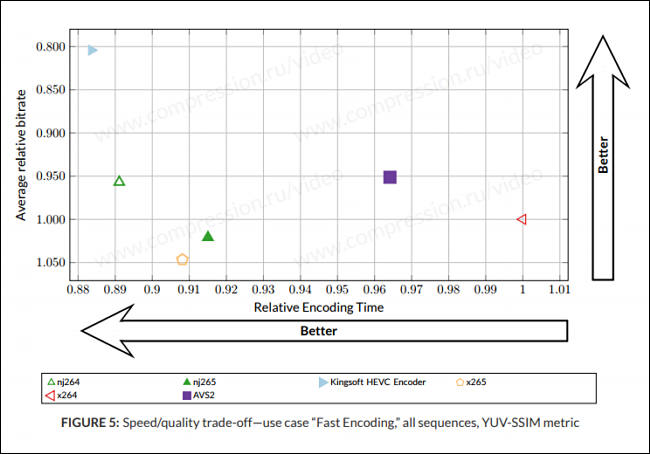
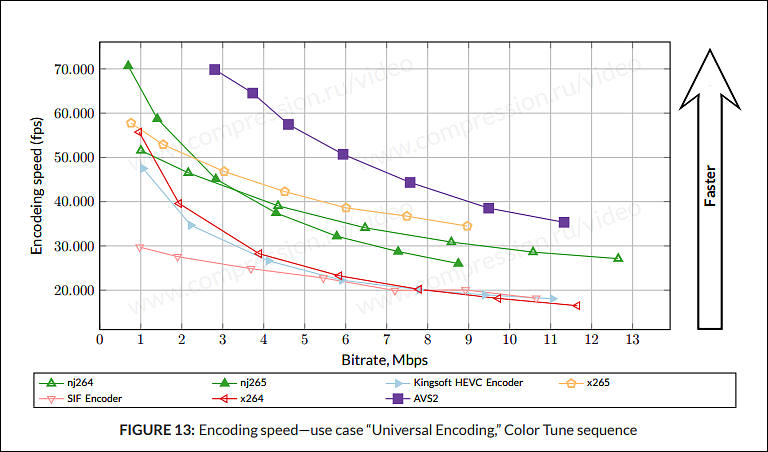
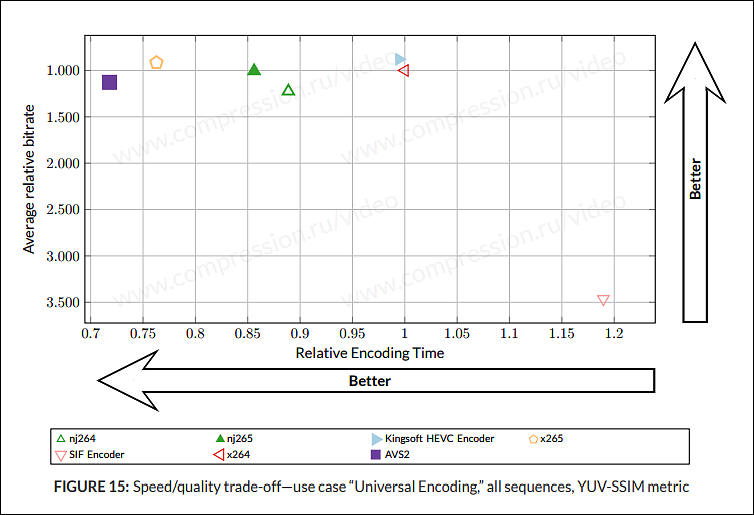
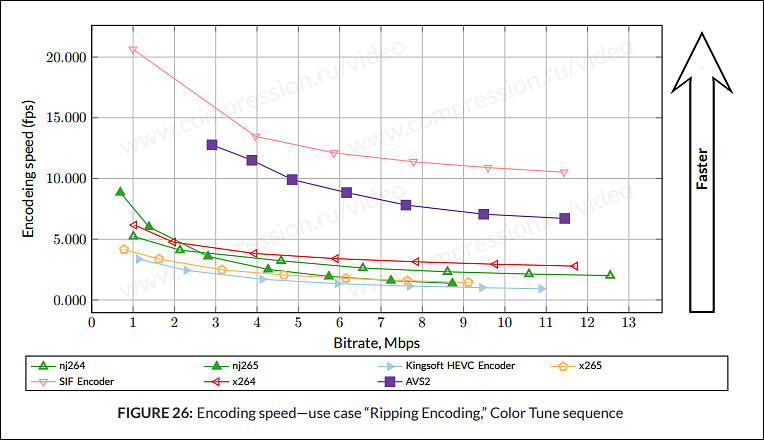
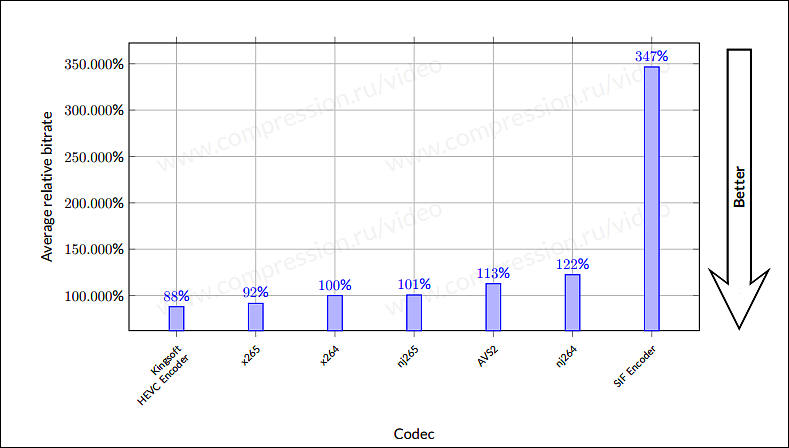
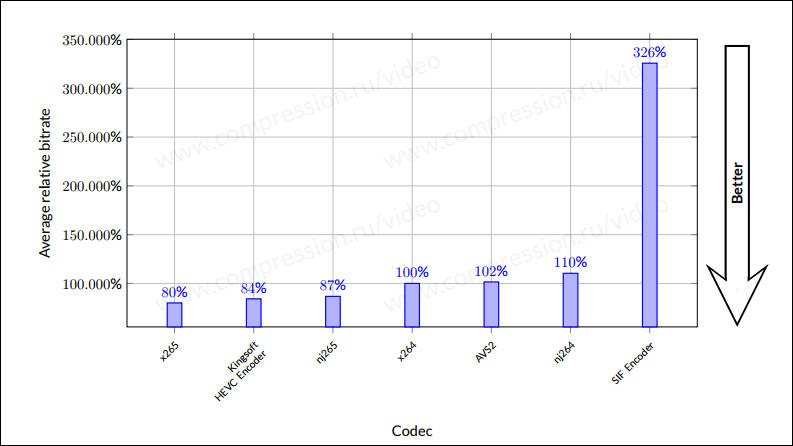
To be short - they push Kingsoft encoder, but it is good for fast encoding only.
If you want to produce final product (Ripping part) you should use x265.
http://compression.ru/video/codec_comparison/hevc_2017/MSU_HEVC_comparison_2017_free.pdf

 sa133.jpg650 x 454 - 45K
sa133.jpg650 x 454 - 45K
 sa134.jpg768 x 452 - 66K
sa134.jpg768 x 452 - 66K
 sa135.jpg754 x 515 - 63K
sa135.jpg754 x 515 - 63K
 sa137.jpg764 x 440 - 62K
sa137.jpg764 x 440 - 62K
 sa138.jpg789 x 448 - 48K
sa138.jpg789 x 448 - 48K
 sa140.jpg793 x 446 - 43K
sa140.jpg793 x 446 - 43K -
I have a Dell Desktop that's a few years old. CPU is i73770 3.4ghz, 12gig of ram, AMD Radeon 7700 graphics. Windows 8.1. Is that enough to edit natively with either the latests version of Vegas or Premiere? Shooting with NX500. Smooth playback in the timeline being a primary consideration.
-
After long pause DJI Inspire 2 joined Samsung NX cameras as having HEVC encoding
http://www.personal-view.com/talks/discussion/16051/dji-inspire-2-with-3-eyes-and-hevc-now
-
They are consistent, you just ignore that video set differ completely and also settings differ.
MSU never use slowest encoding. And Netflix results are for most extreme case, as they later stream it to millions of people, so even if they can save 1% it is big.
-
Speed aside, the above presented results look inconsistent:
The slides in your posting from 6:26AM claim that a x265 encoding can save 45% bitrate at the same SSIM score for 1080p video over a x264 encoding.
The second chart in your posting from 6:40AM only shows only a 20% saving of bitrate for a fixed SSIM score for x265 over x264.
In my personal experience, the latter (20% saving for h.265 vs. h.264) is the much more realistic figure to expect.
-
Another good fresh comparison from MSU
Fast encoding for Intel QuickSync is better than x264 levels
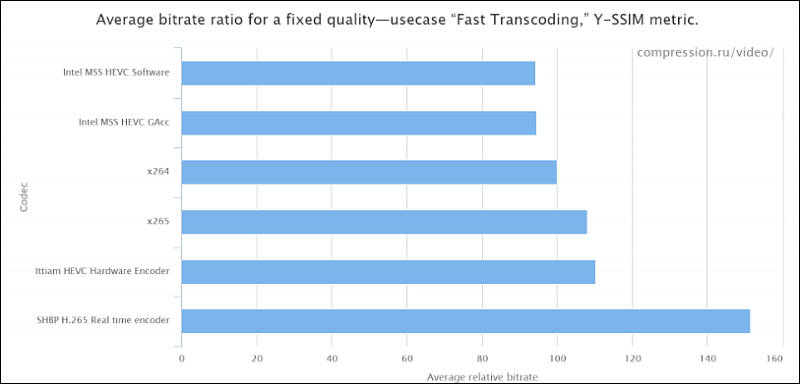
And same for slower encode
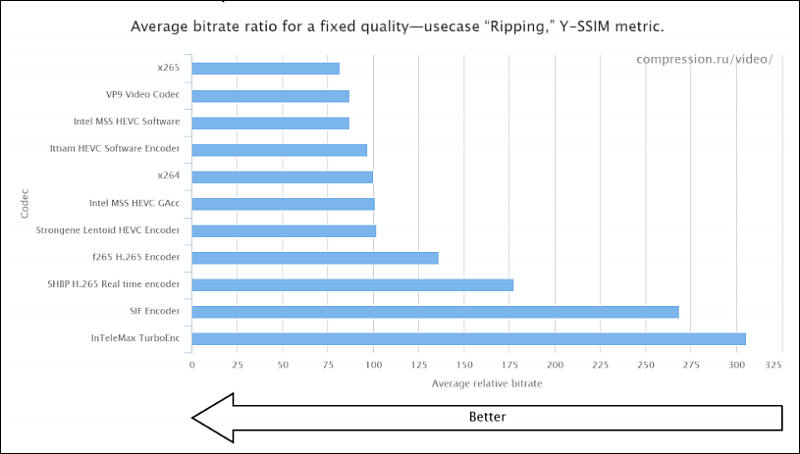

 img2546.jpg800 x 384 - 34K
img2546.jpg800 x 384 - 34K
 img2545.jpg800 x 454 - 43K
img2545.jpg800 x 454 - 43K -
A Large-Scale Comparison of x264, x265, and libvpx
Start at 1 hour mark
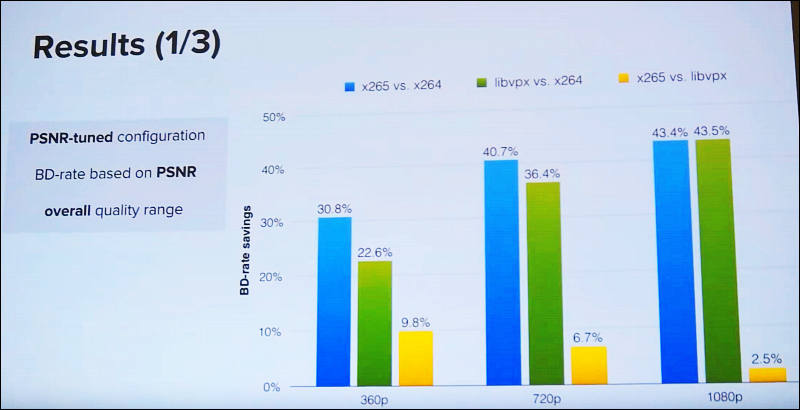
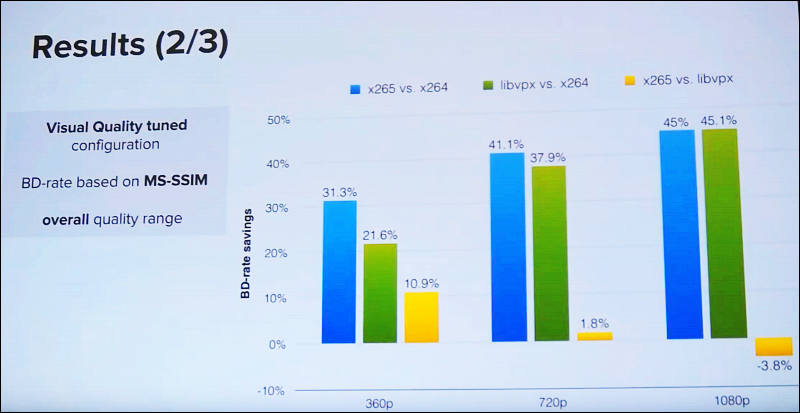
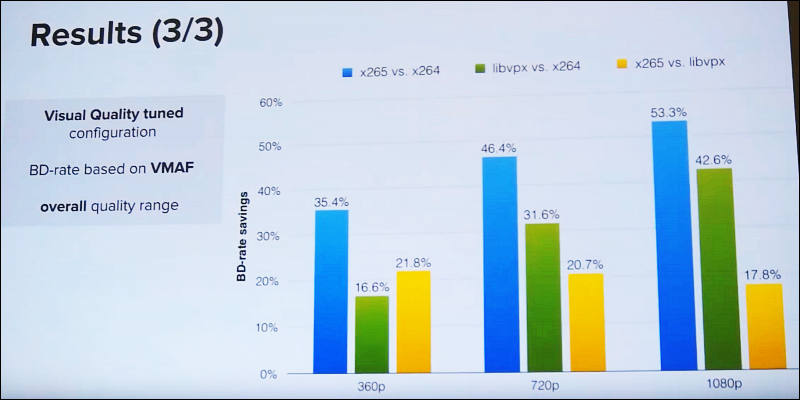

 img2547.jpg800 x 410 - 40K
img2547.jpg800 x 410 - 40K
 img2548.jpg800 x 413 - 39K
img2548.jpg800 x 413 - 39K
 img2549.jpg800 x 400 - 38K
img2549.jpg800 x 400 - 38K -
As usual, they will fight over the peanuts until the elephant starves.
-
About the AV1 Codec
As mentioned, AV1 is expected to ship as early as December 2016, and no later than March 2017. The initial AV1 implementation will incorporate some features of Daala and Thor, but most of the code will come from VP10, which was scheduled to ship by the end of 2016.
The Alliance is targeting an improvement of 50 percent over VP9/HEVC with reasonable increases in encoding and playback complexity. One focus is UHD video, including higher bitrate, wider color gamut, and increased frame rates, with the group targeting the ability to play 4K 60fps in a browser on a reasonably fast computer. The base version of the codec will support 10-bit and 12-bit encoding, as well as the BT.2020 color space. Another focus is providing a codec for WebRTC (Real-Time Communications), an initiative supported by Alliance members Google and Mozilla, and similar applications including Microsoft's Skype.
http://www.streamingmedia.com/Articles/Editorial/What-Is-.../What-is-AV1-111497.aspx
-
Good article, slightly naïve
To accelerate HEVC adoption, I propose that HEVC patent licensors agree to the following principles;
- All HEVC patent holders should make their patents available through a patent pool
- Ideally, all patent holders should join one patent pool
- Only one reasonable royalty should be paid per device
- Software decoding on consumer devices must be royalty free
- Software encoding on consumer devices must be royalty free
- Content distribution must be royalty free
- There must be a reasonable cap on total royalties owed for HEVC implementations
-
outside China HEVC is not popular at all due to the royalty issues. But in China we start seeing that HEVC standard being well widely adopted and a lot of people are using them in for Chinese internal consumption. So I think that HEVC definitely is China market only.
So HEVC legal shit continues.
-
Rockchip that supports H265 hardware playback
-
AMD APUs Bristol Ridge and Stoney Ridge come with HEVC support
-
YES jajaja can't edit previous post.
Is H264, there is like Vitaliy said a 20% aprox. smaller size in H265 but in my system it renders on Hydrid at about 15fps in decent quality, in NVIDIA NVENC H.264speeds up to 80fps, its a huge difference maybe for people with GTX9xxx graphics it's ok to go H265 for now for the rest of us not really. Too much time, small benefit.
You can get decent quality from full HD complete movie in about 1.7 / 1.8 Gb aprox. in H264. In H265 you can go for 1.1 /1.2 Gb Exact same quality and maybe is my settings but I prefer the texture detail more in H264, in H265 there is some strange smooth going on, need to tweak more on Hybrid settings that by any means are simple jajajajaja
Thanks all
-
I think he means the NVIDIA NVENC H.264 Encoder, right?
-
You mean just H.264?
-
Thanks, yes I noticed that also, but time is very consuming as for my system, so ended up using Hybrid with NVENC X264, at about 80fps at decent quality, huge difference.
Hope they get this codec ready to use soon it´s very promising. ;-)
-
You won't save much on H.265 compared to good software based x264 for now, like 10-20% may be.
Almost all GPU encoders are made for speed, not quality.
-
Hi guys, one question as I´m trying to save some space on my hd converting movies to H265, is there any way or any software as for today that is capable of gpu H265 encoding, on old graphics like GTX5xx or 6xxx, as far as I found out there is only NVENC HEVC running in CTX9xxx. On hybrid or mediacoder, saw other payed options too.
I assume it is possible to use the compute power on old GPUs to do this but it looks like there is only development to the internal video chip of the cards. And old Chips are not compatible with HEVC H265.
Some ideas?
Getting from 3 to 15 fps and cpu only as for today.
Thanks
Howdy, Stranger!
It looks like you're new here. If you want to get involved, click one of these buttons!
Categories
- Topics List23,993
- Blog5,725
- General and News1,354
- Hacks and Patches1,153
- ↳ Top Settings33
- ↳ Beginners256
- ↳ Archives402
- ↳ Hacks News and Development56
- Cameras2,368
- ↳ Panasonic995
- ↳ Canon118
- ↳ Sony156
- ↳ Nikon96
- ↳ Pentax and Samsung70
- ↳ Olympus and Fujifilm102
- ↳ Compacts and Camcorders300
- ↳ Smartphones for video97
- ↳ Pro Video Cameras191
- ↳ BlackMagic and other raw cameras116
- Skill1,960
- ↳ Business and distribution66
- ↳ Preparation, scripts and legal38
- ↳ Art149
- ↳ Import, Convert, Exporting291
- ↳ Editors191
- ↳ Effects and stunts115
- ↳ Color grading197
- ↳ Sound and Music280
- ↳ Lighting96
- ↳ Software and storage tips266
- Gear5,420
- ↳ Filters, Adapters, Matte boxes344
- ↳ Lenses1,582
- ↳ Follow focus and gears93
- ↳ Sound499
- ↳ Lighting gear314
- ↳ Camera movement230
- ↳ Gimbals and copters302
- ↳ Rigs and related stuff273
- ↳ Power solutions83
- ↳ Monitors and viewfinders340
- ↳ Tripods and fluid heads139
- ↳ Storage286
- ↳ Computers and studio gear560
- ↳ VR and 3D248
- Showcase1,859
- Marketplace2,834
- Offtopic1,320








